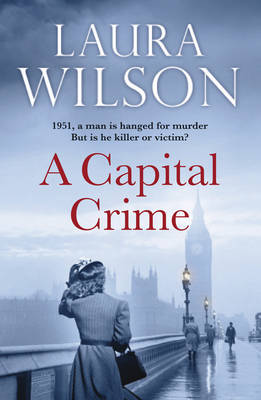
EURO CRIME
Reviews

Wilson, Laura - 'A Capital Crime'
Paperback: 352 pages (Mar. 2011) Publisher: Quercus Publishing Plc ISBN: 1849163103
A CAPITAL CRIME is the third book featuring DI Ted Stratton from West End Central station in London. It is winter 1950 and Stratton is advised that a John Davies has walked into Merthyr Tydfil police station and confessed to murdering his wife and has handed over his 14-month-old daughter to another tenant, Norman Backhouse.
When Stratton investigates the murder, he finds that the only evidence tying Davies to the murder is circumstantial. When Davies starts to protest his innocence and implicates Backhouse, Stratton examines all the evidence but proceeds with the prosecution. Davies is convicted and although protesting his innocence is hanged, with his mother saying that Stratton has made a mistake.
Ex-MI5 agent Diana Calthrop (who featured in a previous DI Stratton novel) is leaving her husband and trying to find somewhere to live and a job. When she starts work in a film studio, she works with Stratton's daughter Monica, which reawakens Stratton's feelings for Diana.
When a body is found at Backhouse's flat, Stratton has to investigate and the case of Davies comes to mind. Further investigation at the property shows that a number of women have been murdered (including Backhouse's wife) and so Backhouse is considered to be the most likely killer. Could he also have been the killer of Davies's wife as John Davies had suggested up to his death?
As a manhunt for Backhouse starts, it is obvious that he is continuing to kill and can Stratton catch him before he kills again. When Diana Calthrop goes missing, Stratton thinks that Backhouse has taken her.
Stratton fits the mould of so many detectives in crime novels - a lonely man after the death of his wife during the war, who lives for his job. The book very clearly shows the struggle undergone by policemen investigating capital crimes knowing that mistakes can lead to an innocent man's death. Stratton and his fellow officers, of course, didn't have all the benefits of modern scientific practices, but still needed to solve the case. The book takes the reader back to the post-war period with all of the rationing and spirit of optimism. The story shows the investigative techniques used during this post-war period along with details of some of the scientific examination available to the police. The previous two novels featuring Ted Stratton are based during the war when death was all around and police resources stretched. Having thoroughly enjoyed this novel, I intend reading the previous books to find out more about this particular detective.
Paul Blackburn, Scotland
April 2011
Details of the author's other books with links to reviews can be found on the Books page.
More European crime fiction reviews can be found on the Reviews page.